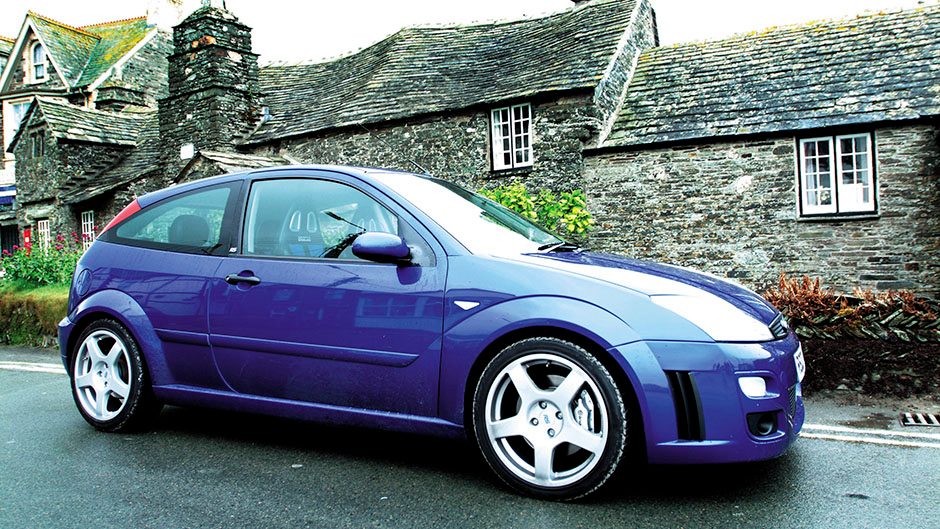The ‘rally special’ wish list goes something like this: turbocharged four-cylinder engine, tick; sports seats, tick; adaptive all-wheel drive, tick. It’s a formula well subscribed to by the likes of Subaru and Mitsubishi, whose sundry WRX Imprezas, STis and Lancer Evolutions find a willing pool of enthusiastic buyers in this country. Given the rise and rise of rally culture in most of the world’s markets, it’s a little puzzling that only Japanese brands have bought into to the cult of the rally special so far.
European hatchbacks seeking to cash in on their WRC success tend to be front-drive only, as evidenced by the test of the new Peugeot 206 GTi 180 last month, and the Ford Focus RS this time around. At least the hottest Focus does have a turbo under the bonnet, but alas, no four-wheel-drive system to process the extra power it produces. Were the Focus RS to be imported here – where there’s a WRX or Evo owner lurking at virtually every traffic light – it would be a little like bringing a scalpel to a gunfight.
Hence the long contemplation of the corporate navel over the viability of the RS for our market. We find ourselves as circumspect as Ford NZ as well, especially after driving the car for three days in England. As a showcase of a vibrant rallysport industry, the hottest Focus has plenty of pedigree thanks to contributions from Sparco (seats), Garrett Technologies (turbo), Brembo (brakes), OZ Racing (wheels), Sachs Racing (dampers), Quaife (differential) and AP Racing (clutch).
Drive the RS, and you soon know that this Focus has received lots of bits from the same suppliers that play supporting roles with the factory WRC rally team. Trouble is, those parts don’t come cheap, and the car could well end up priced above the WRX in our market if it gets the green light. Given the front-drive powertrain, and performance that feels slightly inferior from the seat of the pants, the RS could be on a hiding to nothing in the inevitable comparison test with the WRX Impreza that will be conducted by this magazine.
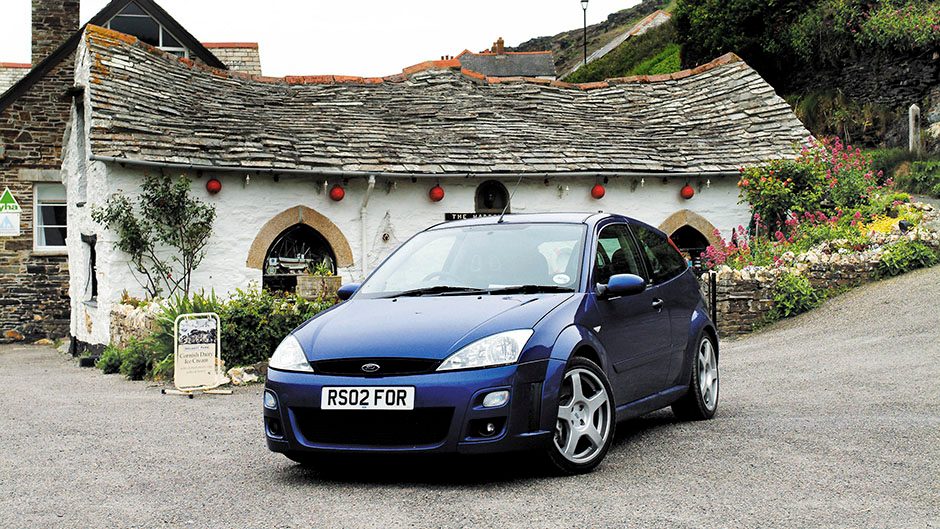
Don’t get the impression, however, that the RS isn’t a hoot to drive. It’s a bigger provider of leery grins than the Focus ST170, which is the current performance flagship in the New Zealand range. It’s just that there is an overwhelming impression that all those special parts should add up to a car that’s, well, slightly more special. Unfortunately for the RS, the compromises are all too apparent from the moment you thumb the green (for “go you bastard”, presumably) starter button.
Biggest trade-off of all is the lack of a couple of extra diffs and another driveshaft. Ask Ford UK why the turbocharged Focus has to channel its enhanced power and torque to just the front wheels, and you’ll get one of two answers, depending on which department the reply comes from. The PR man said it hasn’t got all-wheel drive “because it doesn’t need it”. But then, he would say that. Meanwhile, an engineer said the rear diff and driveshaft wouldn’t fit beneath the current Focus body without severe (read: expensive) surgery.
Although we prefer the engineer’s answer, to some degree both are right. In a European context, the RS doesn’t need AWD, as the direct competitors – notably the Renault Clio Cup and Mini Cooper S Works – are also front-drivers. And the RS has gone down a treat in its continent of origin. “Hot hatches don’t come much hotter than this,” gushed one UK reviewer, while another warned in the normally conservative Times that the RS will “smash your frail body into those generous Sparco seats with a brutal charge”.
Coming into all this hype from a down-under perspective, one would expect the RS to be an absolute axe-murderer of a car. But for someone who drove an Impreza STi to Auckland airport on his way to picking up the RS at Heathrow, the RS feels tame, and – kidney-pummelling low-speed ride aside – almost civilised. First impressions confirm that this is the girl next door of the rally specials.
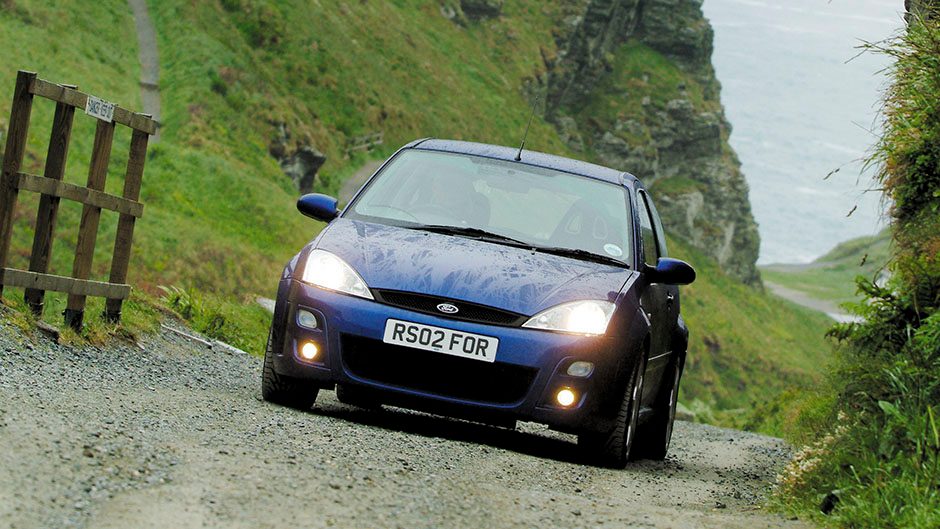
Most of this is due to the over-working of the front tyres. The 225/40ZR18 Michelin Pilot Sport radials are of a suitable width and compound to accommodate the sporty aspirations of the RS, but it’s simply too much to ask them to steer the car and transmit the power of a turbocharged engine at the same time. Ford has recognised the stressful over-functioning of the front rubber with some clever programming of the engine management computer.
In the two lowest gears, which give engine torque the most leverage over the traction of the front tyres, the engine ECU turns down the boost provided by the turbo, restricting the potential for torque-steer. So you don’t get the full boost of 1.2 bar of the Garrett turbo until you’ve safely slotted the lever of the five-speed manual gearbox into third. As a result, the 2.0 litre Duratec inline four delivers a torque peak of 240 Nm at 3500 rpm in the lowest two forward ratios, and 310 Nm in the upper three gears!
Ford was obviously quite anal about the driver of the RS fighting with the 158 kW engine for control of the car’s direction, for it fitted a second line of defence against torque-steer as well. The adaptive Quaife front differential is a unit capable of distributing torque from side to side according to available traction. And if that’s still not enough, the beefed-up driveshafts are of differing weights – carefully selected to discourage the dreaded bogey of turbocharged front-drivers further.
Suffice to say then, that what torque-steer you’ll find at the wheel of the RS won’t rip the wheel out of your hands as you exit a smooth turn on full throttle. Yet there is still enough to imagine what a turbo-terror the car could have been without all the counter-measures: a Ford version of a Saab Viggen, maybe. Instead you’ve got the performance persona akin to a Ralliart Diamante’s front-drive powertrain (the manual version with the LSD, of course) in a more agile-handling package. As in the big-bore Aussie six, there is a wealth of mid-range muscle on offer, and enough of a top-end sprint to allow fulfilment of V8-humbling fantasies. Ford claims a 0-60 mph (98 km/h) time of 6.4 seconds, but Markko Martin must have been at the wheel. We found the 180 kW/1493 kg Ralliart manual capable of a 0-100 km/h sprint in 7.2 seconds, and measured its kilogram-to-kilowatt count at 8.29. With 158 kW motivating 1287 kg of mass, the Focus RS has 8.14 kg for every individual kilowatt to move. Given this near power-to-weight parity, we’d expect a 0-100 time of around 7.0 seconds from the fastest Focus, and that’s about as fast as the RS feels.
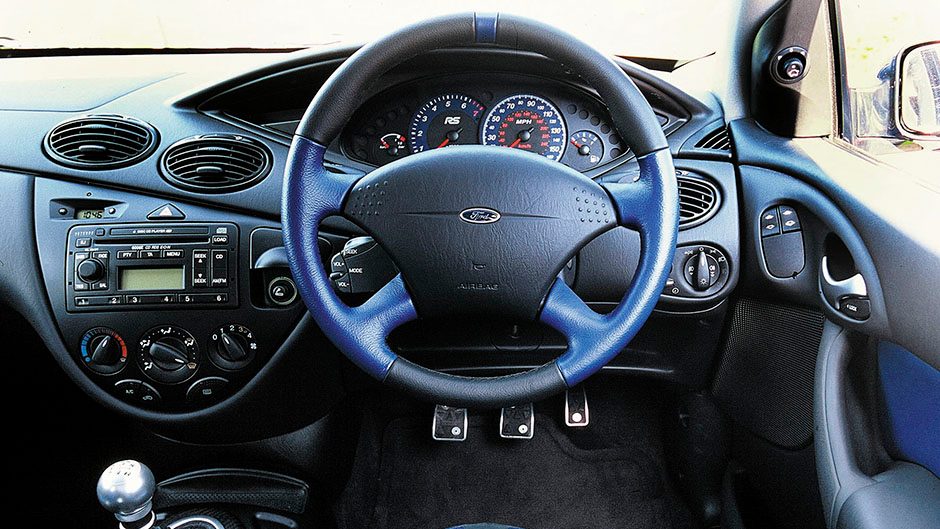
There’s no traction control fitted, which is only logical given the ESP-unfriendly Quaife LSD Ford chose to put the power to the road. What isn’t so logical is the reduced ratio count in the transmission. Instead of the ST170’s tight and precise six-speed, there’s a sloppy five-speed manual that would be more suited to the base 1.6 Focus. Oddly, our UK colleagues mostly applauded this move. Perhaps sixth is a gear too far for them. No complaints, however, about the clutch from AP Racing, which is resilient enough to take plenty of 0-100 test abuse in its stride, yet light of effort, and precise in its release of torque to the front wheels. If the powertrain is mild rather than wild, the RS chassis is the Full Monty track day special in its suspension tuning and body-roll control. So much so, the RS gets quite unruly over broken surfaces.
It’ll toss its head like a thoroughbred racehorse in bumpy bends, bouncing off line as the tyres struggle to keep in contact with the road. The same well-sorted steering rack as the ST170 directs the RS, yet the fatter tyres have reduced some of the road feedback, and the extra torque of the turbocharged engine has diminished its accuracy. Get on the gas hard coming onto a bumpy straight, and the beautifully trimmed wheel literally dies in your hands – then instantly assumes some blood-hungry afterlife as the evil mistress of Count Torque-Steeracula. All the engineering work Ford did to drive a wooden stake through the heart of the latter comes undone as soon as the ultra-firm suspension bounces a front wheel clear of the road.
Perhaps the bumpy, sinuous tarmac of North Cornwall wasn’t on the test development route chosen by Ford’s engineers as they sorted the RS – a smooth race track more like. For the smoother and faster the corner, the more the RS likes it. Speed drives a measure of compliance into the unyielding ride of the Sachs dampers and beefed-up springs, and an even surface restores the accurate and talkative steering normally associated with a Focus. In such circs, Ford’s lateral-g figure of 0.94 before the car succumbs to understeer seems utterly believable. The car’s levels of mechanical grip on a good surface are so high that few owners will encounter understeer on such roads.
When they do, a throttle lift gets the RS to obey the steering wheel again, but, as said, it’s a remedy needed rarely. Most of the time, the RS driver can stay on the gas and drive the car through the corner, secure in the knowledge that the Quaife and ‘barred-up’ chassis tune have all the front-end traction and weight-transfer issues sorted. The middle pedal also identifies the RS as a true blue-blooded sports machine. The harder you use the Brembo brakes, the more they seem to relish the extra work. Stopping performance is eye-popping, and we’d estimate 100-0 in around 33 metres.
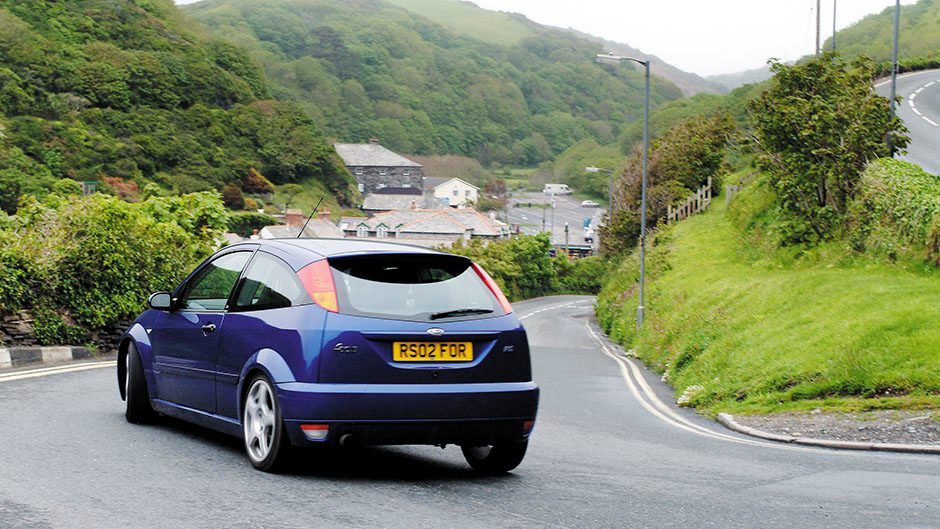
Inside, the Focus design base comes back to bite the RS on the backside. With its seats, alloy pedals, gear shift and handbrake levers, Sparco tried to lift the car above its mainstream hatchback origins. However, the nicely supportive buckets are mounted a bit high, giving the impression that this is some sort of hot people-mover you’re driving. Meanwhile, the stereo is normal Focus fare: adequate in the everyday models, but not the eardrum-bleeder expected of a fast and furious Focus.
And who is the product-planning guru who decreed that sporty cars are somehow even sportier when fitted with starter buttons? Certainly slows a fast getaway outside the bank – although it does ensure that an RS takes a few minutes longer to steal. Still, there are a couple touches worthy of as much applause as the front exterior design, with its more aggressive demeanour. One is the visual cue that this is the Focus WRC you’re driving, suggested via the strip of blue leather mounted at ‘top dead centre’ on the steering wheel. The other is the shift-warning light that blinks at 6000 rpm, although this is 750 rpm before the engine-speed limiter shuts the ignition down.
Ford NZ says that it is “highly unlikely” that the Focus RS will come here. This isn’t due to any reluctance to import the hottest Focus, more the result of supply constraints. Ford has now built all 4500 units of the RS model that it’s ever going to assemble. Meanwhile, they’re hard at work on a 200+ kW 4wd successor that will also include the magic word ‘Cosworth’ in the model nomenclature. Now that’s the hot Focus we’d rather see come here. Till then, the more user-friendly Focus ST170, so competent over our bumpy roads, will tide us over nicely until the ‘Cossie’ arrives, thank you Henry.
| Model | 2003 Ford Focus RS | Price | $49,000 |
| Engine | 1998cc, IL4, T/EFI, 158kW/310Nm | Drivetrain | 5-speed manual, front-wheel drive |
| Fuel Use | XL/100km | C02 Output | Xg/km |
| 0-100km/h | 6.4sec | Weight | 1287kg |
